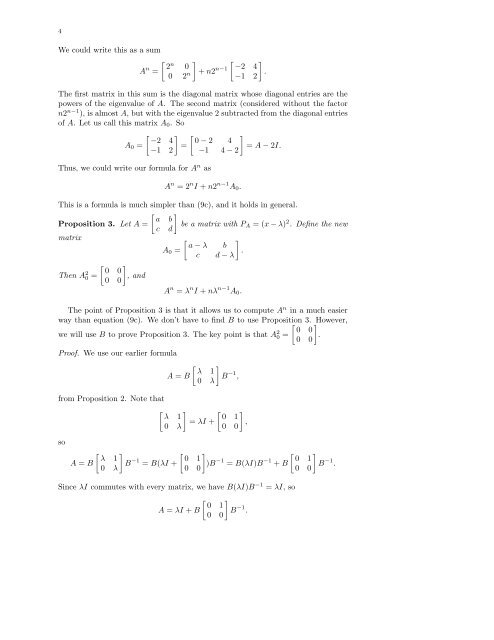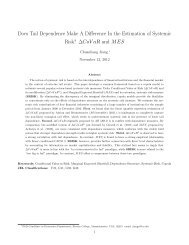Linear Algebra Notes Chapter 9 MULTIPLE EIGENVALUES AND ...
Linear Algebra Notes Chapter 9 MULTIPLE EIGENVALUES AND ...
Linear Algebra Notes Chapter 9 MULTIPLE EIGENVALUES AND ...
Create successful ePaper yourself
Turn your PDF publications into a flip-book with our unique Google optimized e-Paper software.
4<br />
We could write this as a sum<br />
[ ] [ ]<br />
A n 2<br />
n<br />
0<br />
=<br />
0 2 n + n2 n−1 −2 4<br />
.<br />
−1 2<br />
The first matrix in this sum is the diagonal matrix whose diagonal entries are the<br />
powers of the eigenvalue of A. The second matrix (considered without the factor<br />
n2 n−1 ), is almost A, but with the eigenvalue 2 subtracted from the diagonal entries<br />
of A. Let us call this matrix A 0 . So<br />
A 0 =<br />
[<br />
−2<br />
]<br />
4<br />
−1 2<br />
Thus, we could write our formula for A n as<br />
=<br />
[ ]<br />
0 − 2 4<br />
= A − 2I.<br />
−1 4 − 2<br />
A n = 2 n I + n2 n−1 A 0 .<br />
This is a formula is much simpler than (9c), and it holds in general.<br />
[ ]<br />
a b<br />
Proposition 3. Let A = be a matrix with P<br />
c d<br />
A = (x − λ) 2 . Define the new<br />
matrix<br />
[ ]<br />
a − λ b<br />
A 0 =<br />
.<br />
c d − λ<br />
[ ]<br />
0 0<br />
Then A 2 0 = , and<br />
0 0<br />
A n = λ n I + nλ n−1 A 0 .<br />
The point of Proposition 3 is that it allows us to compute A n in a much easier<br />
way than equation (9c). We don’t have to find B to use Proposition [ 3. ] However,<br />
0 0<br />
we will use B to prove Proposition 3. The key point is that A 2 0 = .<br />
0 0<br />
Proof. We use our earlier formula<br />
from Proposition 2. Note that<br />
A = B<br />
[ ]<br />
λ 1<br />
B −1 ,<br />
0 λ<br />
[ ]<br />
λ 1<br />
= λI +<br />
0 λ<br />
[ ]<br />
0 1<br />
,<br />
0 0<br />
so<br />
A = B<br />
[ ]<br />
λ 1<br />
B −1 = B(λI +<br />
0 λ<br />
[ ]<br />
0 1<br />
)B −1 = B(λI)B −1 + B<br />
0 0<br />
[ ]<br />
0 1<br />
B −1 .<br />
0 0<br />
Since λI commutes with every matrix, we have B(λI)B −1 = λI, so<br />
A = λI + B<br />
[ ]<br />
0 1<br />
B −1 .<br />
0 0
















